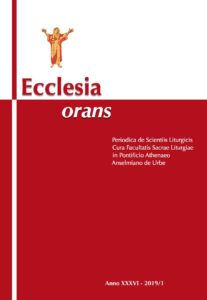Editorial
The first 2019 issue of Ecclesia orans is also the first issue of our journal’s 36th year. Its release is almost simultaneous to the fifth volume of the series on Liturgiewissenschaft, which has been the journal’s companion since 2016. This fifth volume presents the reader with the Proceedings of the 11th International Liturgy Conference on Liturgy and Culture held in St. Anselm, May 9-11, 2018. Several circumstances have prompted our series to change its name so that the second volume of the new series of Ecclesia orans. Studi e ricerche, in sequential order, is the fifth volume contributing to the academic and scientific study of the liturgy.
Following in the footsteps of their predecessors, this issue is the first to be edited by the journal’s new editorial staff. They deliver a collection of contributions on various topics to the international scientific community. The passing of the well-known liturgist Prof. Robert Taft on November 2 of last year urged the editors to ask Stefano Parenti, tenured professor of Oriental liturgies of the Pontifical Liturgical Institute, to contribute to the journal with a reflection on Taft’s research and doctrine legacy. A further contribution on the late liturgist will appear in this year’s second issue. Nathan P. Chase of the University of Notre Dame, under the title Apta diei et loco: the Votive Masses in the Holy Land, offers scholars a work on votive Masses in the Holy Land, where he highlights the function of space as an often underestimated dimension of the Christian ritual system. The contribution of Daniel P. McCarthy of the Pontifical Liturgical Institute deepens the funeral liturgy as a fulfillment of Christian initiation and Christian life from a historical-theological and pastoral point of view. The work is entitled, A Gentle Light in Mourning, Fulfilling Christian Initiation and Life at Funerals. Strasbourg’s emeritus liturgist, Marcel Metzger, authored the contribution of L’eucharistie, source de vie. Un message trop ignoré that revolves around the liturgical epiphany of the new life in Christ. Christian prayer and life cannot be conceived but with an intimate liturgical bond. This follows the statement of SC 10, which considers the liturgy as the culminating action that the Church tends to, and at the same time, the source from which she takes her energy.
Scholarly reviews complete the issue. These allow the reader to value several publications that have been sent to the journal and are relevant for its liturgical focus. A list of publications received by the editorial staff closes the issue.
The origin of the authors who contributed to this issue, both through their studies and reviews, reflects the international approach of the Faculty of Liturgy of the Pontifical Athenaeum of St. Anselm in Rome. Such international character is evident in the composition of the teaching body and in the students’ origin. This is a continuously renewed gift of mutual enrichment in terms of thought, as well as scientific research and teaching. In fact, every scientific activity grows in dialogue, beyond any disciplinary boundaries.
We wish you good reading in hopes that the latest issue of Ecclesia orans can contribute to such a dialogue.
MARKUS TYMISTER
Editor in Chief
